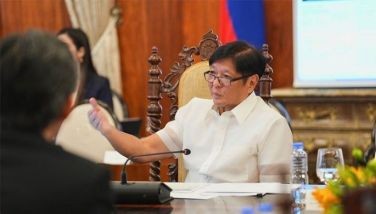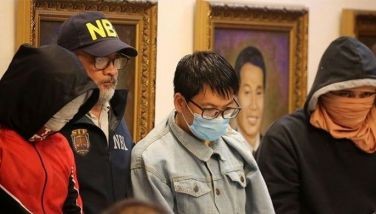Journalists as heroes: The legacy of Plaridel
August 29, 2004 | 12:00am
The history of the Philippines and its revolutions is a colorful and telling tale of personal sacrifice, political and philosophical differences, chaos and cockbrained pride, courage and final glory. For if in other countries the image of a warrior with a sword or soldier and his gun has, at each instance, inspired wars, in the Philippines, the pen has constantly been the filibustero’s weapon of choice against the country’s enemies – foreign and domestic.
From the protest literature of Jose F. Lacaba, Ramon Vicente Sunico, Cirilo F. Bautista, Alfred Yuson, et al. during the martial law years up to the first EDSA revolution, to the tradition of nationalist and satirical writings of seasoned journalists and opinion writers such as Max Soliven, the late Louie Beltran, and of course, the late senator and former Manila Times correspondent Benigno "Ninoy" Aquino Jr., et al., there’s only one inspirational seed from which all these have originated: the Propaganda Movement of 1880 as led by writer-editor Marcelo H. del Pilar.
Marcelo Hilario del Pilar y Gatmaytan was a native of Bulacan and raised in Colegio de San Jose whom he knew the Filipino priest and martyr Padre Burgos. He was a young prodigy who lived with a Filipino priest Father Mariano Sevilla, during the first outbreak of Spanish persecution and hostilities in 1872 against indio clergymen. Father Sevilla was one of those exiled in the Marianas Islands in the aftermath.
Little was known about Del Pilar’s life during this period save for the fact he graduated with a law degree at the University of Santo Tomas. He came into the glare of history when he started a group of Filipino student nationalists that launched the first Tagalog-Spanish bilingual newspaper in the Philippines, the Diargyong Tagalog. This newspaper, funded for the most part by relatives of Del Pilar and some of his associates, was the very first of its kind, owned and run by Filipinos and carried reformist and nationalist ideas during the Spanish colonial times.
The Diaryong Tagalog wasn’t the first publication where young Filipino nationalists had bled their quills. The year 1872 to 1882 was the period we could call the "First Quarter Storm" of Filipino student activism during the Spanish colonial times.
The so-called ilustrados, or educated ones, young Filipino students belonging to fairly affluent families who were able to study abroad, particularly Spain, started engaging in writing activities and book projects to promote reformist ideas in Madrid, though subtly at first. The likes of Pedro Paterno, Gregorio Sancianco, Graciano Lopez Jaena were among the budding writers who first delved into polemics and literary bantering in a number or publications, through the hard works of Jose Rizal and Juan Atayde, the bi-weekly newspaper Revista del Criculo Hispano-Filipino was born some 10 years after the execution of the three priests Gomburza.
These publications paved the way for other periodicals to hit the newsstands. A year later, a Spanish-owned newspaper called Los Dos Mundos became the venue for articles written by Graciano Lopez Jaena, Pedro Azcarraga and Tomas del Rosario. the articles that appeared in these publications were not the "hard-hitting" articles one would expect from supposedly radical student activists. Assimilation into the Spanish Cortes and equality between Spaniards and Filipinos were the first issues they tackled, which is sort of a cloak-and-dagger forerunner to then desire for full independence. But the seed of Filipino nationalist thought were already beginning to take root around this time within the Filipino student communities in Europe. Most articles were in defense of the supposedly uneducated indio, whom the friars often tagged as indolent, apathetic and lazy.
The more radical essays of Rizal and Lopez Jaena were initially published in the Spanish republican newspaper El Progreso. The journals El Liberal, Diario de Manila El Globo, El Globo, El Emparcial and La Publicidad among others were also used as mediums for Filipino protest writings. It was during the creation of the newspaper España En Filipinas, the publication of the Filipino community in Madrid, that reformist ideas were accepted as the norm and essence of Filipino protest writing. It ran at centerstage in just a short span of time but would later die due to the disunited nature of leadership among the young ilustrados in Madrid. Around the same time, Jose Rizal was busy putting the finishing touches on his first novel Noli Me Tangere which was thereafter published in Berlin, Germany. The novel was to eventually form a more literary yet nationalistic approached to defend the indio and expose the abuses of the Spanish friars.
But it was the newspaper established by Marcelo Del Pilar (editor-in-chief), Jose Rizal, Graciano Lopez Jaena, Mariano Ponce and Pablo Rianzares in Barcelona that took the bull by the horns and became the arena of battle for reform and independence — the La Solidaridad. Its mission was "to combat all reaction, to impede all retrogression, to applaud and accept every liberal idea, to defend all progress; in a word; one more propagandist of all ideals of democracy, aspiring to make democracy prevail in all the peoples both of the Peninsula and of the overseas provinces. . ."
The obvious potential La Solidaridad displayed spurred young nationalists to join the polemical bandwagon, the more active of which were Damaso and Mariano Ponce, Jose Ma. Panganiban, T. H. Pardo de Tavera, Eduardo Casal, Isabelo de los Reyes, and even the Austrian professor and La Solidaridad supporter Ferdinand Blumentritt.
Del Pilar, writing under his nom de plume "Plaridel," was one of the foremost champions of Filipino nationalistic thought and freedom of expression during the dark days of the Spanish colonials. He worked as editor and opinion writer, and even translator of some of Rizal’s works into Tagalog. He was also the official delegate in Spain of the Comite de Propaganda of Manila, a committee created by the ilustrados to initially campaign and lobby in Madrid for the country’s inclusion in the Spanish Cortes (Congress). It was a polemical strategy Del Pilar used to slowly introduce the idea if autonomy and final independence of the Philippines to the Spanish government.
As was expected by Del Pilar, the La Solidaridad proved to be an effective medium for propaganda, which in years that passed had strongly influenced Spanish politicians in Madrid and Barcelona and deferred for a time the persecution of indios by the friars in Manilda. The first issue of La Solidaridad were received by Filipino communities in Europe enthusiastically. According to historian John N. Schumacher, SJ in his book The Propaganda Movement 1880-1885. "Four hundred copies were sent to the Philippines, a hundred more to Basa, with the request to send to Manila those he did not need. Soon Serrano was asking for 1,500 copies, despite the difficulties of getting the paper into the country. . ." After the first few issues, the La Solidaridad moved in full swing.
The quest for reform and assimilation into the Spanish government, which was the first stage towards full autonomy and independence of the Philippines, was clear in the mind of Del Pilar and his compatriots Mariano Ponce and Jose Rizal from the beginning.
Plaridel was a great believer in the "destiny reserved by Providence for our race. . ." At the outset, he made every effort through his writings to convince Spain of the need for proper education for the natives, the learning of Spanish, for genuine assimilation in the Spanish Congress, the privilege of natives to become part of the clergy and freedom of expression, among others, if progress and peace in the Archipelago were to be achieved. He did not risk cutting corners; his research and arguments were almost always flawless. His pamphlets and articles for the natives on the other hand were largely written in flowing, eloquent Tagalog, which he wanted to become the national language if ever the country would be granted full independence by the Spaniards one day. Having been a law student, he was, for the most part, an avid learner of Spanish politics and a critic of Spanish lifestyle and social practices, which he found altogether repulsive.
At the height of the Propaganda Movement, Plaridel launched La Solidaridad in Madrid. He functioned as sole editor and moving spirit of the newspaper in the city. At this point, financial support was increasing and so were the influx of protest articles by nationalist writers Jose Rizal, Ferdinand Blumentritt, Antonio Luna, Dominardo Gomez and Mariano Ponce. With all that money coming in, Plaridel lived a hand-to-mouth existence nonetheless.
With Rizal wanting to come back to the Philippines, Spain was faced with confronting the struggle for independence from two fronts: Madrid and Manila — the bastions of ilustrado intellectual might. The strategy was something neither Spain nor the friars anticipated. Though hundreds of miles apart, Del Pilar and Rizal had always fixed their sights on the same end — independence for the Philippines. The effort in journalism and literature had shored up the work of reform and independence in the Propaganda Movement’s darkest hour. Both chose the path less taken Rizal took the avenue of heroic sacrifice. Rizal was from head to foot a man possessed and conscious of his mission to the very end, even to the point, as some historians say, of rejecting a plan of Andres Bonifacio to save him from inevitable execution. After having returned to the Philippines, he was immediately exiled in Dapitan only to face the firing squad in Bagumbayan, Manila in the name of freedom.
Del Pilar, on the other hand, took the strenuous road to convincing Spain of the jegitimacy of treating Filipinos as equals. When Rizal was banished to Dapitan, it was Del Pilar’s writings that cut a broad swathe across the friars’ thickening persecution of indios in the Philippines. Plaridel, in due course, died a very poor man in a foreign country, turning his back on riches in exchange for the hope of independence, and because of love for country.
Both journalists died as heroes, never seeing where the Philippines is today.
(This article on Marcelo H. del Pilar was submitted to Samahang Plaridel, the Journalists’ association, by writer Joel P. Salud in celebration of Del Pilar’s 154th birth anniversary.)
From the protest literature of Jose F. Lacaba, Ramon Vicente Sunico, Cirilo F. Bautista, Alfred Yuson, et al. during the martial law years up to the first EDSA revolution, to the tradition of nationalist and satirical writings of seasoned journalists and opinion writers such as Max Soliven, the late Louie Beltran, and of course, the late senator and former Manila Times correspondent Benigno "Ninoy" Aquino Jr., et al., there’s only one inspirational seed from which all these have originated: the Propaganda Movement of 1880 as led by writer-editor Marcelo H. del Pilar.
Marcelo Hilario del Pilar y Gatmaytan was a native of Bulacan and raised in Colegio de San Jose whom he knew the Filipino priest and martyr Padre Burgos. He was a young prodigy who lived with a Filipino priest Father Mariano Sevilla, during the first outbreak of Spanish persecution and hostilities in 1872 against indio clergymen. Father Sevilla was one of those exiled in the Marianas Islands in the aftermath.
Little was known about Del Pilar’s life during this period save for the fact he graduated with a law degree at the University of Santo Tomas. He came into the glare of history when he started a group of Filipino student nationalists that launched the first Tagalog-Spanish bilingual newspaper in the Philippines, the Diargyong Tagalog. This newspaper, funded for the most part by relatives of Del Pilar and some of his associates, was the very first of its kind, owned and run by Filipinos and carried reformist and nationalist ideas during the Spanish colonial times.
The so-called ilustrados, or educated ones, young Filipino students belonging to fairly affluent families who were able to study abroad, particularly Spain, started engaging in writing activities and book projects to promote reformist ideas in Madrid, though subtly at first. The likes of Pedro Paterno, Gregorio Sancianco, Graciano Lopez Jaena were among the budding writers who first delved into polemics and literary bantering in a number or publications, through the hard works of Jose Rizal and Juan Atayde, the bi-weekly newspaper Revista del Criculo Hispano-Filipino was born some 10 years after the execution of the three priests Gomburza.
These publications paved the way for other periodicals to hit the newsstands. A year later, a Spanish-owned newspaper called Los Dos Mundos became the venue for articles written by Graciano Lopez Jaena, Pedro Azcarraga and Tomas del Rosario. the articles that appeared in these publications were not the "hard-hitting" articles one would expect from supposedly radical student activists. Assimilation into the Spanish Cortes and equality between Spaniards and Filipinos were the first issues they tackled, which is sort of a cloak-and-dagger forerunner to then desire for full independence. But the seed of Filipino nationalist thought were already beginning to take root around this time within the Filipino student communities in Europe. Most articles were in defense of the supposedly uneducated indio, whom the friars often tagged as indolent, apathetic and lazy.
The more radical essays of Rizal and Lopez Jaena were initially published in the Spanish republican newspaper El Progreso. The journals El Liberal, Diario de Manila El Globo, El Globo, El Emparcial and La Publicidad among others were also used as mediums for Filipino protest writings. It was during the creation of the newspaper España En Filipinas, the publication of the Filipino community in Madrid, that reformist ideas were accepted as the norm and essence of Filipino protest writing. It ran at centerstage in just a short span of time but would later die due to the disunited nature of leadership among the young ilustrados in Madrid. Around the same time, Jose Rizal was busy putting the finishing touches on his first novel Noli Me Tangere which was thereafter published in Berlin, Germany. The novel was to eventually form a more literary yet nationalistic approached to defend the indio and expose the abuses of the Spanish friars.
The obvious potential La Solidaridad displayed spurred young nationalists to join the polemical bandwagon, the more active of which were Damaso and Mariano Ponce, Jose Ma. Panganiban, T. H. Pardo de Tavera, Eduardo Casal, Isabelo de los Reyes, and even the Austrian professor and La Solidaridad supporter Ferdinand Blumentritt.
Del Pilar, writing under his nom de plume "Plaridel," was one of the foremost champions of Filipino nationalistic thought and freedom of expression during the dark days of the Spanish colonials. He worked as editor and opinion writer, and even translator of some of Rizal’s works into Tagalog. He was also the official delegate in Spain of the Comite de Propaganda of Manila, a committee created by the ilustrados to initially campaign and lobby in Madrid for the country’s inclusion in the Spanish Cortes (Congress). It was a polemical strategy Del Pilar used to slowly introduce the idea if autonomy and final independence of the Philippines to the Spanish government.
As was expected by Del Pilar, the La Solidaridad proved to be an effective medium for propaganda, which in years that passed had strongly influenced Spanish politicians in Madrid and Barcelona and deferred for a time the persecution of indios by the friars in Manilda. The first issue of La Solidaridad were received by Filipino communities in Europe enthusiastically. According to historian John N. Schumacher, SJ in his book The Propaganda Movement 1880-1885. "Four hundred copies were sent to the Philippines, a hundred more to Basa, with the request to send to Manila those he did not need. Soon Serrano was asking for 1,500 copies, despite the difficulties of getting the paper into the country. . ." After the first few issues, the La Solidaridad moved in full swing.
Plaridel was a great believer in the "destiny reserved by Providence for our race. . ." At the outset, he made every effort through his writings to convince Spain of the need for proper education for the natives, the learning of Spanish, for genuine assimilation in the Spanish Congress, the privilege of natives to become part of the clergy and freedom of expression, among others, if progress and peace in the Archipelago were to be achieved. He did not risk cutting corners; his research and arguments were almost always flawless. His pamphlets and articles for the natives on the other hand were largely written in flowing, eloquent Tagalog, which he wanted to become the national language if ever the country would be granted full independence by the Spaniards one day. Having been a law student, he was, for the most part, an avid learner of Spanish politics and a critic of Spanish lifestyle and social practices, which he found altogether repulsive.
At the height of the Propaganda Movement, Plaridel launched La Solidaridad in Madrid. He functioned as sole editor and moving spirit of the newspaper in the city. At this point, financial support was increasing and so were the influx of protest articles by nationalist writers Jose Rizal, Ferdinand Blumentritt, Antonio Luna, Dominardo Gomez and Mariano Ponce. With all that money coming in, Plaridel lived a hand-to-mouth existence nonetheless.
Del Pilar, on the other hand, took the strenuous road to convincing Spain of the jegitimacy of treating Filipinos as equals. When Rizal was banished to Dapitan, it was Del Pilar’s writings that cut a broad swathe across the friars’ thickening persecution of indios in the Philippines. Plaridel, in due course, died a very poor man in a foreign country, turning his back on riches in exchange for the hope of independence, and because of love for country.
Both journalists died as heroes, never seeing where the Philippines is today.
(This article on Marcelo H. del Pilar was submitted to Samahang Plaridel, the Journalists’ association, by writer Joel P. Salud in celebration of Del Pilar’s 154th birth anniversary.)
BrandSpace Articles
<
>
- Latest
- Trending
Trending
Latest
Trending
Latest
Recommended
January 21, 2025 - 12:00am






























